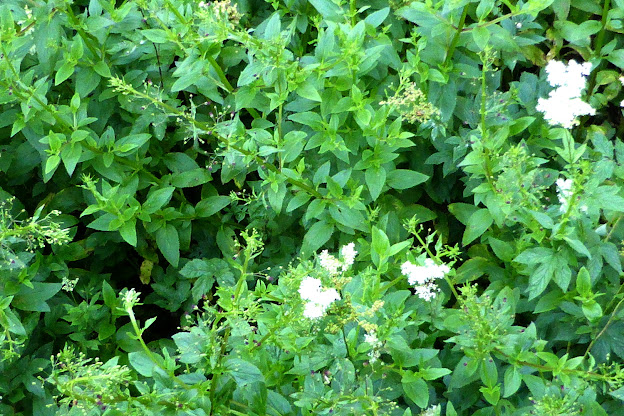I remember learning to recognise Figwort as a small child - to me, the dark red flowers like little helmets are intriguing and distinctive. It has square stems. It belongs to the Figwort Family - Scrophulariaceae. The fruit is a TWO-celled ovary.
1. Common Figwort - Scrophularia nodosa
So it is different to the Lamiaceae (labiates) whose fruit is FOUR nuts together, nestling the green calyx, as in as Wild Basil, Betony, Selfheal and Bugle
Common Figwort grows in "weedy disturbed habitats". - such as in towns. I found some by the Ribble just south of Settle earlier this year, and yesterday I found some at the Hoffmann Kiln yesterday including in the area that the Council would like to develop. It is a common plant. (See map at end of this post)
Key feature: Its four sided stem is NOT winged.
------------
2. Water Figwort
Water Figwort Scrophularia auriculata and Green Figwort Scrophularia umbrosa both have winged stems and look very similar to each other and grow in wet places.
Long ago I used to call every Figwort I found with a winged stem "Water Figwort" because the distribution map show it is much commoner than Green Figwort.
However... All the figwort plants with winged stems I have looked at in the last few years around Settle have turned out to be the much less common Green Figwort Scrophularia umbrosa.
We found some with the BSBI in ditches in the fields that flood near the Ribble south of Runley Bridge last July on their Summer Trip, and also just below the Skipton Bypass.
This week I went to the Hoffmann Kiln near Langcliffe. There are two deep trenches/ cuttings where trains came to either the side of the kiln with trucks to collect the Lime. Although the one at the east (hill) side dried up in the drought in May, it is normally filled with a deep wet pool. Earlier in the year I had seen a big figwort growing in it so I went back this week. The pool was too deep and brambly to wade in. I leaned of the edge of the footpath and took photos:
 |
Green Spleenwort at the Hoffmann Kiln, growing amongst Meadowsweet |
I am happy it is Green Figwort because Green Figwort has rhizomes; it has up to 40 to 50 serrate-crenate teeth on each side of the leaves, and the base of the leaf tends to be cuneate. (
Water Figwort on the other hand, is tufted not rhizomatous, has 25-32 teeth per side of leaf, and is more cordate at the base of the leaf
But I could not access a flower. So I show here is a photo of the flower I collected at Skipton Bypass last year
If you look inside a Figwort flower you will see it has four stamens (anther on a stalk) and the fifth stamen is replaced by a dark red staminaode (a sterile stamen) just above them. In Green Figwort the staminode has TWO lobes: (Water Figwort would just have one lobe)
If you know of a Water Figwort site near Settle do Tell me.
Below: Maps taken from the BRC and BSBI website.
 |
| Green Figwort - S umbrosa |
 |
| Water Figwort - Scrophularia auriculata |
 |
| Common Figwort - Scrophularia nodosa |






No comments:
Post a Comment